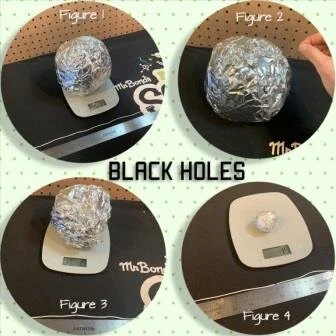Creating a Black Hole
Ever wondered what makes a black hole so powerful?
In this experiment, we can explore density and gravity using objects you already have at home!
Supplies:
Balloons
Aluminum foil
String
Markers
Ruler
Kitchen scale
Push-pin
Now Follow These Steps:
Step 1: Inflate and tie the balloon. Try to blow it up to the shape of a sphere.
Step 2: Cover the entire balloon with aluminum foil.
Step 3: To measure the circumference of your star, wrap a string around the middle of the balloon. Use a marker to note the length of the string. Measure the length of the string using a ruler.
Step 4: Place the star on a kitchen scale or triple beam balance and determine the mass. (Figure 1)
“Try to gently compress your star- the pressure from the burning core of the star keeps the layers of gas from collapsing!”
Step 5: It's time for your star to become a supernova! Using a push-pin, carefully pop the balloon. (Figure 2)
Step 6: Slightly crush the foil to decrease the volume.
Step 7: Measure and record the circumference of the star, again.
Step 8: Determine the mass of your supernova. (Figure 3)
When the star's core runs out of fuel, it can no longer hold up the layers. Gravity compresses the star.
Step 9: Now fully crush the star into as small of a ball as possible. Get creative!
Step 10: Measure and record the circumference and mass of your black hole. (Figure 4)
Even though the black hole is much smaller, the mass (how much material is inside) stays the same which makes the density (how compact something is) much higher.
“Try putting a new, unpopped star in a tub of water-it floats! Now try the dense black hole- it sinks!”
If we want to calculate the actual density from our circumference ( C ) and mass, we can use these equations:
Our model was nearly 40 times denser by the end!
Black holes are so dense that not even light can escape their gravitational pull.
Just last year, in 2019, scientists were able to take the very first picture of a black hole by turning the Earth into a giant telescope. Learn more about their discovery here: https://youtu.be/GgfySOiJ6Oc
Sources:
https://www.scienceinschool.org/2013/issue27/blackholes
Beyond the Black Hole: Modeling an Imploding Star, 2013 National Math + Science Initiative, Dallas, Texas. www.nms.org.




